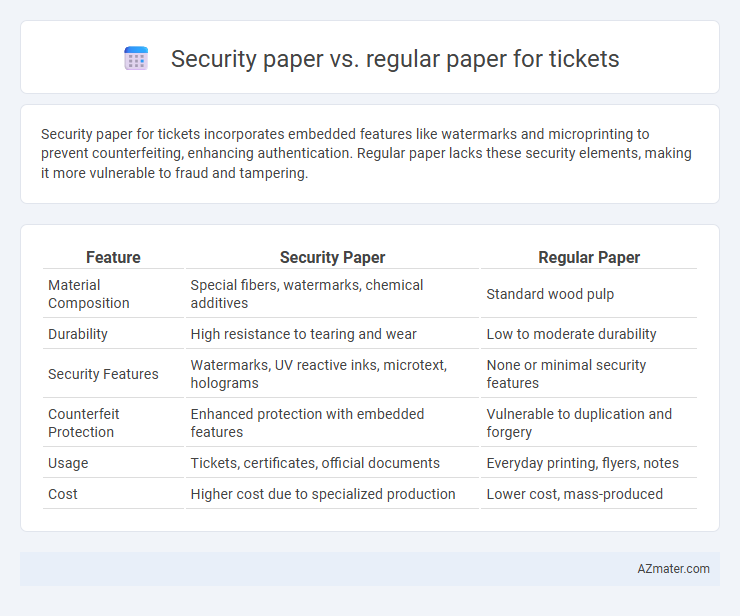Security paper for tickets incorporates embedded features like watermarks and microprinting to prevent counterfeiting, enhancing authentication. Regular paper lacks these security elements, making it more vulnerable to fraud and tampering.
Table of Comparison
| Feature | Security Paper | Regular Paper |
|---|---|---|
| Material Composition | Special fibers, watermarks, chemical additives | Standard wood pulp |
| Durability | High resistance to tearing and wear | Low to moderate durability |
| Security Features | Watermarks, UV reactive inks, microtext, holograms | None or minimal security features |
| Counterfeit Protection | Enhanced protection with embedded features | Vulnerable to duplication and forgery |
| Usage | Tickets, certificates, official documents | Everyday printing, flyers, notes |
| Cost | Higher cost due to specialized production | Lower cost, mass-produced |
Introduction to Ticket Paper Types
Ticket paper types primarily include security paper and regular paper, each serving distinct purposes in event management and authentication. Security paper features embedded anti-counterfeiting elements such as watermarks, holograms, and UV-reactive fibers, enhancing protection against forgery and unauthorized duplication. Regular paper, typically plain and cost-effective, is suited for low-risk tickets where high-level security is not a critical concern.
What is Security Paper?
Security paper is a specially manufactured paper embedded with anti-counterfeit features such as watermarks, microtext, security fibers, and invisible fluorescent threads, making it ideal for printing tickets, certificates, and legal documents. Unlike regular paper, security paper prevents forgery and unauthorized duplication through these built-in security elements, ensuring authenticity and integrity. The integration of these features helps organizations maintain control over ticket issuance and reduces fraud risks in event management and transportation sectors.
Features of Regular Paper
Regular paper used for tickets is typically made from standard wood pulp with a smooth finish, offering basic printability and cost-effectiveness. It lacks advanced security features such as watermarks, microprinting, or UV-reactive inks, making it more susceptible to tampering and counterfeiting. This paper type is ideal for low-risk environments where durability and anti-fraud measures are not critical.
Key Security Features in Ticket Printing
Security paper for ticket printing incorporates embedded features such as watermarks, microtext, and UV-sensitive fibers to prevent counterfeiting and unauthorized duplication. These protective elements ensure ticket authenticity and enhance event security by making forgery detection straightforward. Regular paper lacks these specialized attributes, making it vulnerable to tampering, unauthorized copying, and fraud in ticket distribution.
Cost Comparison: Security Paper vs Regular Paper
Security paper, designed with embedded features like watermarks and micro-printing, typically costs 15-30% more per sheet than regular paper due to specialized manufacturing processes. Bulk purchasing can reduce the cost difference, but the price of security paper remains higher because of its enhanced anti-counterfeiting properties. Regular paper is more economical for standard printing needs yet lacks the fraud-prevention benefits that justify the premium cost of security paper in ticket printing.
Durability and Longevity of Ticket Paper
Security paper exhibits superior durability compared to regular paper due to its enhanced fibers and protective coatings that resist tearing, moisture, and fading. Tickets printed on security paper maintain legibility and structural integrity for extended periods, making them ideal for long-term use or archival purposes. In contrast, regular paper tickets tend to degrade quickly, risking loss of vital ticket information over time.
Counterfeit Prevention: Security Paper Advantages
Security paper incorporates advanced features such as watermarks, microprinting, and embedded fibers, making it significantly harder to duplicate compared to regular paper. These anti-counterfeit elements provide robust protection against forgery by enabling easy verification and deterring unauthorized reproduction. As a result, security paper enhances ticket authenticity, reducing fraud risks in event admissions and transportation.
Applications and Use Cases
Security paper employs embedded features like watermarks, microtext, and UV fibers to prevent counterfeiting, making it ideal for high-value tickets used in concerts, sports events, and transportation. Regular paper lacks these anti-fraud elements and is commonly used for low-cost or disposable tickets where security concerns are minimal. Applications of security paper extend to government-issued passes, access control credentials, and event admissions requiring verification authenticity.
Environmental Impact Considerations
Security paper incorporates embedded features like watermarks and fibers that require specialized production processes, often increasing energy consumption and chemical usage compared to regular paper. Regular paper manufacturing typically has a lower environmental footprint due to simpler processing, lower resource intensity, and greater compatibility with recycling systems. Choosing security paper for tickets necessitates weighing its enhanced anti-fraud benefits against potentially higher ecological impacts from resource extraction and chemical treatments.
Choosing the Right Paper for Your Tickets
Security paper for tickets incorporates advanced features such as watermarks, microprinting, and UV-reactive inks that prevent counterfeiting and ensure authenticity. Regular paper lacks these protective elements, making it suitable for low-risk events but vulnerable to fraud. Selecting the right paper depends on the event's security requirements, with security paper providing higher protection for high-value or restricted-access tickets.

Infographic: Security paper vs Regular paper for Ticket
 azmater.com
azmater.com